Samples
Music
The samples of music that you may access below are from the Bemidji State University Madrigal Dinners, 1968-1998. They are sung by the Bemidji Chamber Singers, directed by Paul Brandvik. The Chamber Singers are a fourteen-voice ensemble that has two fifty minute rehearsals each week.
Carols Three– Willis Music Company, Publisher
Coventry Carol (4:51) 15th Cent. English Carol -“The Compleet Madrigal Dinner Booke”, Curtis Music Press, Publisher. Neil A. Kjos, Distributer |
Sample Script Pages
The sample script pages here are an example of the layout of our scripts. This example comes from the beginning of a Madrigal Dinner. Since each of the thirty scripts is unique, the Jester’s greeting will vary with the script and the overall theme.
In each script, there are fairly extensive notes which precede these pages. These include suggestions for each of the major characters, including style, costumes, characterization, suggestions for the set-up of the hall, and suggestions for any unique qualities specific to that particular script.
View the sample pages. (pdf)
Costumes
The costumes pictured here and elsewhere on this website were designed and built by Mary Lou Brandvik. She based the designs on drawings and pictures of late fifteenth century English costumes. This era was picked for their wonderfully unique hats, the flowing veils, and indistinct edges of the hats and the gowns. These elements all go into the developing of the fantasy of the performance.
Click on any of the thumbnails below to view the images in a larger slide show.
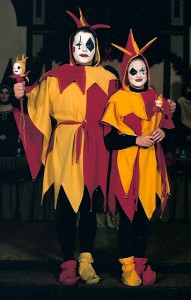 |
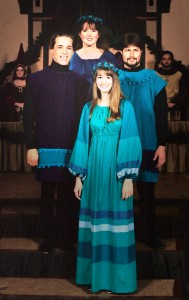 |
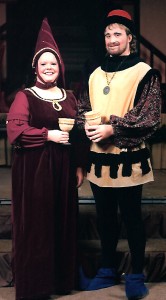 |
 |
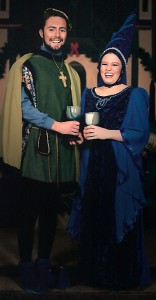 |
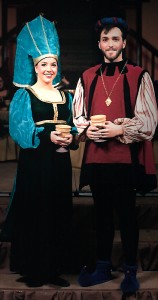 |
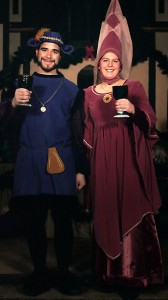 |
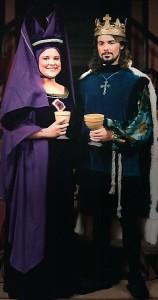 |
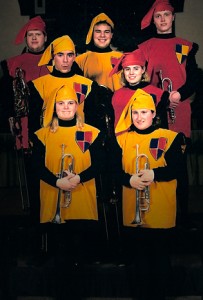 |
Since the Royal Court, who are the performers at the head table in a Madrigal Dinner, is seated, the audience is more aware of their presence if their headgear is visible. This is especially so if the hats are both stunning and beautiful.
Each of the hat designs are based on historical pictures of costumes from this era. However, in the fifteenth century, the tall pointed hats called wimples were worn farther back on the head and the front part of the head was shaved. Try to get modern day women to do that . . . even for art! . . or Fred for that matter. Extra straps were built into these hats so that it was still possible to sing and wear the hats but not at such a rakish angle.
As you might expect, most of the hats went by nicknames, which I am not going to mention at this time. For more information, Mary Lou Brandvik wrote a chapter on costumes in THE COMPLEET MADRIGAL DINNER BOOKE, distributed by Neil A. Kjos Music Publishers. This chapter has drawings and suggestions for building the costumes.
Video
The video clips which you are about to watch are from Bemidji State University’s 1994 Madrigal Dinner. It was entitled “Fools Fall in Love.” You can check the synopsis on the section called “SCRIPTS.” This script is a favorite with many performers and guests.
The first scene is the Wassail ceremony. In our scripts, this happens after the Royal Procession. The servants carry pitchers of wassail for the guests and the two pages carry the wassail bowl. As they reach the head table, they cry out “Wassail” three times and the Wassail song begins. As they sing, the King and Queen fill the goblets with wassail and pass them down to each member of the Royal Court. When the song has ended, but the melody lingers on, the servants pour the wassail for the guests, and various toasts are offered.
The second scene features the three melodically challenged wandering minstrels, Harmonia, Discordio, and Out-of-Tunio. You can tell from their names that they are less than gifted and not entirely serious singers. If you can’t tell, don’t worry; by the end of their singing, you will have no doubts as to who or what they are. This scene comes at the beginning of the Masque (or short little play) and gets the guests into the spirit of the evening. It is a wonderful scene both for the actors and the audience.

